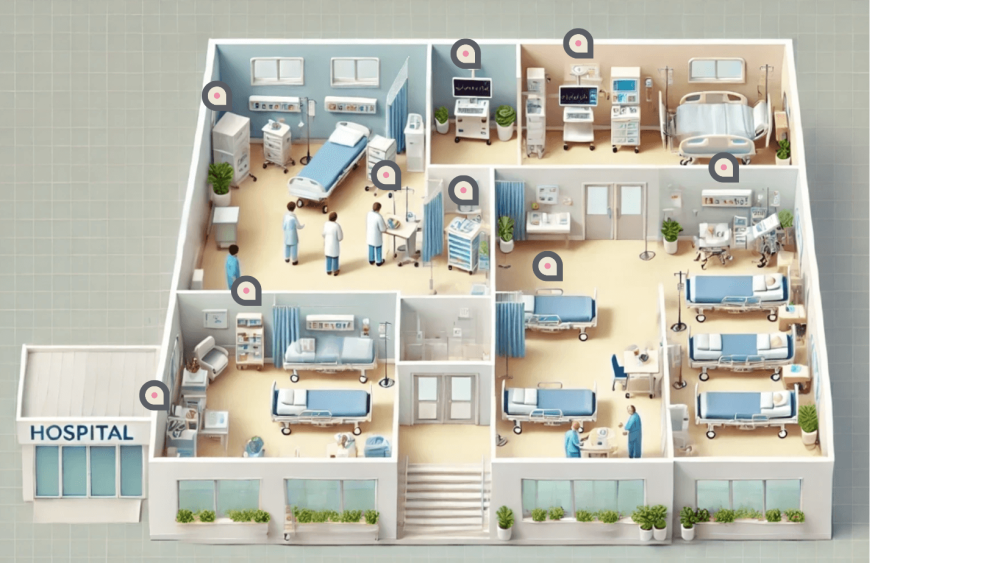
In an era where time is money for most businesses, RTLS can be a game changer. Real-time location systems (RTLS) enable a user to track the location of physical assets or people using either radio frequencies or global positioning systems (GPS)/global navigation satellite systems (GNSS). This helps businesses and organizations know where their important assets are accurately and in real-time.
How Does RTLS Work?
Just how accurate and timely items are tracked fully depends on the technology behind the RTLS.
RTLS operates through a combination of hardware and software components:
- Tags and transmitters are attached to objects or other assets. Each tag has a unique ID for identification.
- Receivers or anchors collect signals from the tags and relay the information to a centralized management system.
- Management software processes the data received from the tags and provides real-time location information on a digital map.
Various wireless technologies like ultra-wideband (UWB), radio frequency identification (RFID), Wi-Fi, and Bluetooth® are used in RTLS. However, UWB RTLS tends to be more accurate, reliable, and secure, and provides real-time positioning data.
The Growing Need for RTLS and UWB RTLS

Although RTLS has been around for three decades, newer technologies like UWB are helping to give the industry a boost. Data from MarketsandMarkets show it's expected to grow from $5.2 billion in 2023 to $16.2 billion by 2028, with an average annual growth rate of 25.5%.
When it comes to RTLS, the technology behind it matters. In fact, the UWB RTLS market is projected to increase from $286 million in 2023 to $602.45 million by 2030.
By integrating RTLS with UWB technology, you can significantly enhance safety measures by continuously monitoring the precise asset location and movement. This is particularly beneficial in hazardous environments, such as construction sites.
In addition to improving safety, UWB RTLS streamlines operations. Enhanced location tracking enables efficient route planning and optimal movement of materials and other assets. It also provides accurate, timely inventory management, crucial for smooth warehouse and factory operations. This tracking ensures items are accounted for and in the right place, reducing delays and boosting productivity.
The Benefits of UWB in RTLS
UWB technology’s exceptional location accuracy and reliability makes it an ideal solution for precise tracking in challenging environments. It offers:
- High Accuracy – UWB can achieve centimeter-level location accuracy, making it ideal for applications requiring precise tracking.
- Robustness – UWB is less affected by signal interference and can penetrate various materials such as wood, plastic, or drywall – making it suitable for challenging environments.
- Real-Time Tracking – UWB provides real-time visibility without the need for a line-of-sight, which is essential for tracking fast-moving or hidden objects.
- Low Power Consumption – UWB tags have low power requirements, leading to longer battery life and reduced maintenance costs.
Real World Use Cases of RTLS and UWB
UWB technology paired with RTLS is transforming many industries by providing accurate tracking and improving efficiency in healthcare, manufacturing, warehousing, and transportation:
Healthcare
- Patient Tracking – RTLS with UWB ensures accurate tracking of patients and staff, improving safety and operational efficiency in healthcare facilities.
- Equipment Management – Hospitals can track medical equipment in real-time, reducing search times, preventing theft, and improving overall asset utilization.
Manufacturing
- Tool Tracking – UWB-based RTLS systems can track tools and materials on assembly lines, ensuring efficient operations and theft prevention.
- Safety Monitoring – Monitoring the location of employees and machinery in real-time can prevent collisions and other workplace accidents.
Warehousing
- Inventory Management – UWB improves the accuracy of inventory tracking, optimizing storage space and reducing the time spent locating items.
- Forklift Tracking – Incorporating UWB into forklifts allows for real-time tracking of their movements, improving route management and efficiency.
Transportation and Logistics
- Asset Tracking – UWB RTLS can track vehicles and cargo in transit, providing real-time visibility and enhancing security.
- Fleet Management – Managing the location and status of vehicles in real-time ensures efficient operations and timely deliveries.
RTLS and UWB – A Transformative Opportunity
RTLS, enhanced by UWB technology, offers transformative benefits across various industries ensuring high accuracy, real-time visibility, and improved operational efficiency. As the market for RTLS and UWB continues to grow and businesses continue to adopt this innovative technology, we can expect to see impressive advancements and benefits across various sectors, ultimately driving productivity and enhancing overall performance.